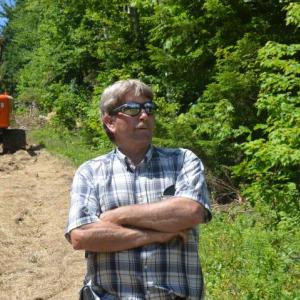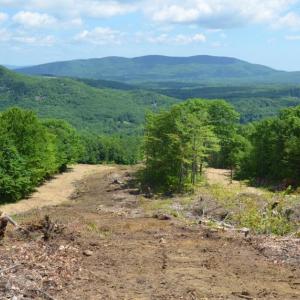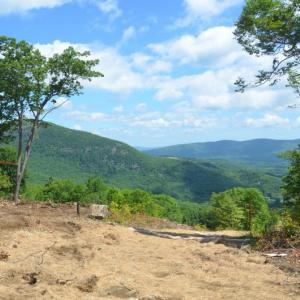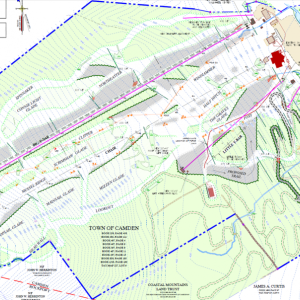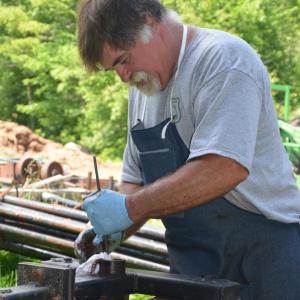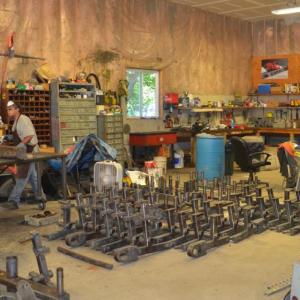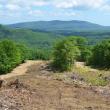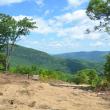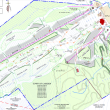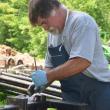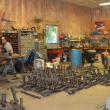Vermont trail builder takes helm with Camden Snow Bowl project, new phase gets under way
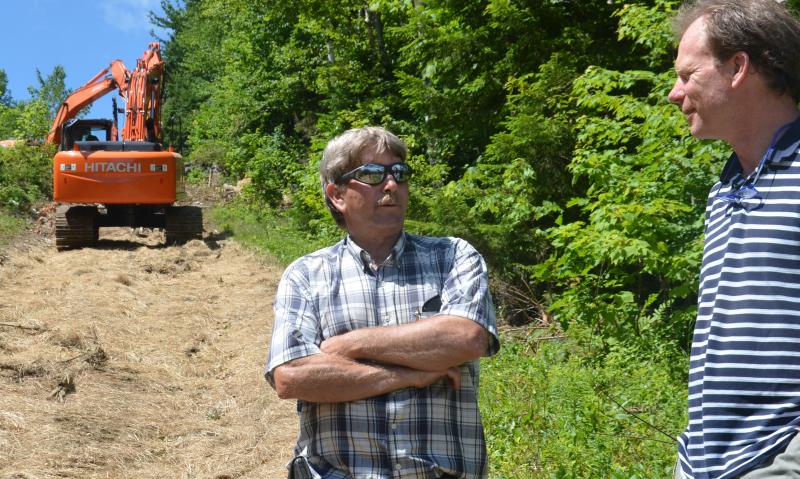 Tom Wells, owner of Royal Trail Works, and Landon Fake, director of parks and recreation for the town of Camden, confer about the Snow Bowl rebuild near the top of Ragged Mountain July 9. (Photo by Lynda Clancy)
Tom Wells, owner of Royal Trail Works, and Landon Fake, director of parks and recreation for the town of Camden, confer about the Snow Bowl rebuild near the top of Ragged Mountain July 9. (Photo by Lynda Clancy)
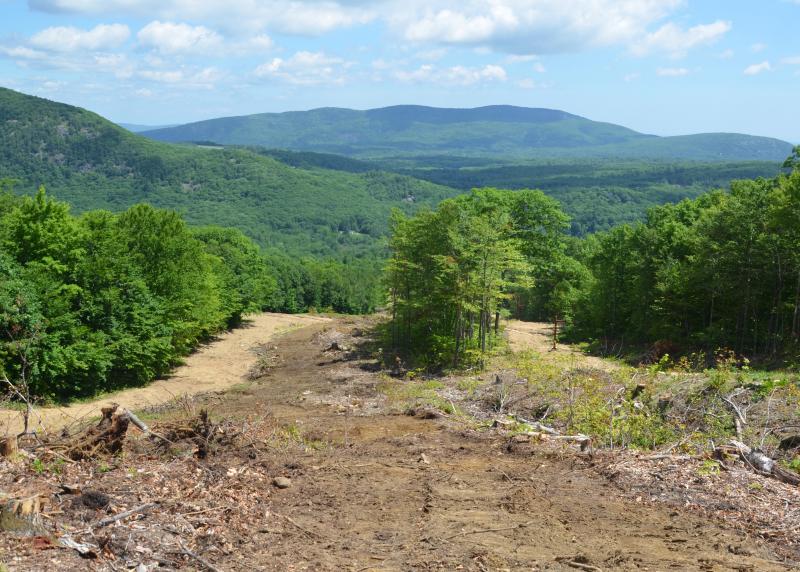 The view down the mountain July 9. (Photo by Lynda Clancy)
The view down the mountain July 9. (Photo by Lynda Clancy)
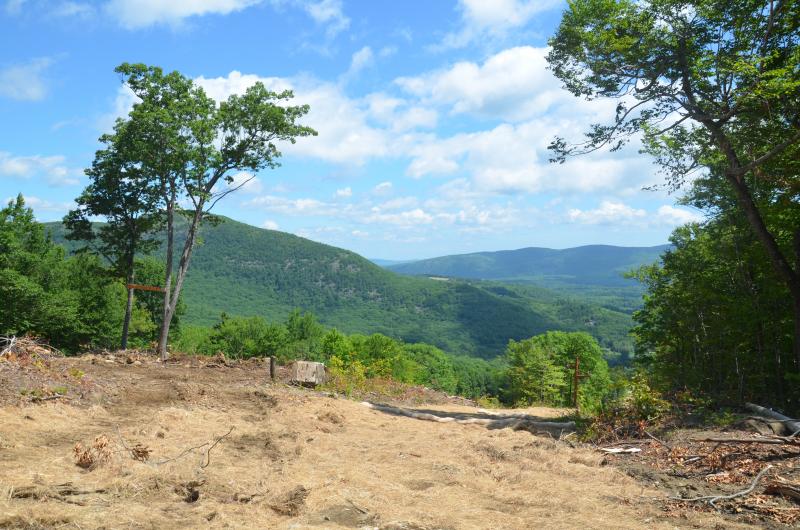
 A map of what has been cut and what is left to cut.
A map of what has been cut and what is left to cut.
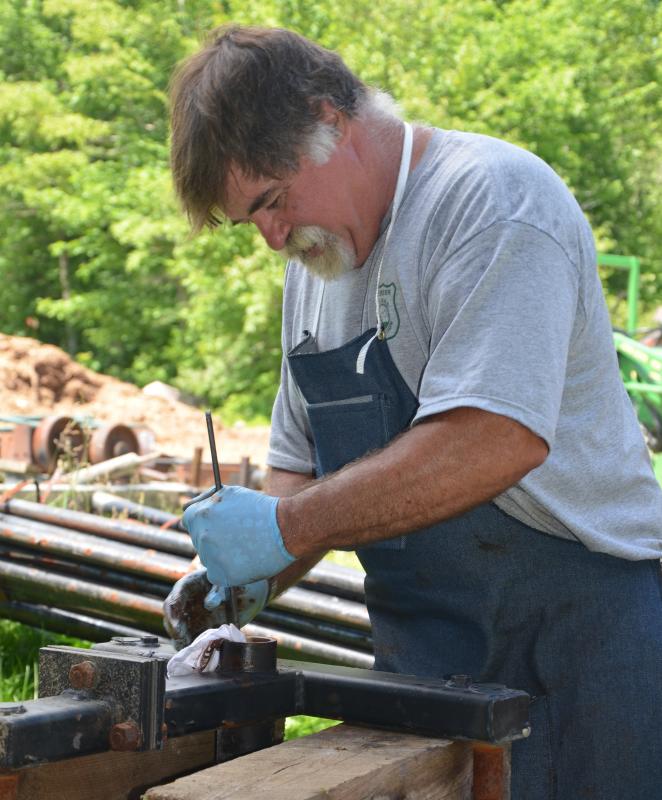 Getting the shivs in condition for the chairlift. (Photo by Lynda Clancy)
Getting the shivs in condition for the chairlift. (Photo by Lynda Clancy)
 The shop at the Camden Snow Bowl, July 9. (Photo by Lynda Clancy)
The shop at the Camden Snow Bowl, July 9. (Photo by Lynda Clancy)
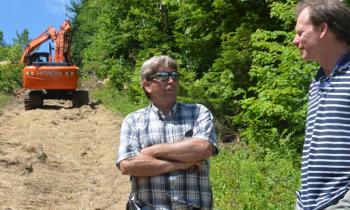 Tom Wells, owner of Royal Trail Works, and Landon Fake, director of parks and recreation for the town of Camden, confer about the Snow Bowl rebuild near the top of Ragged Mountain July 9. (Photo by Lynda Clancy)
Tom Wells, owner of Royal Trail Works, and Landon Fake, director of parks and recreation for the town of Camden, confer about the Snow Bowl rebuild near the top of Ragged Mountain July 9. (Photo by Lynda Clancy)
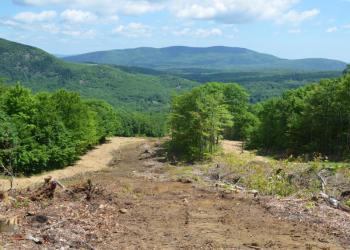 The view down the mountain July 9. (Photo by Lynda Clancy)
The view down the mountain July 9. (Photo by Lynda Clancy)
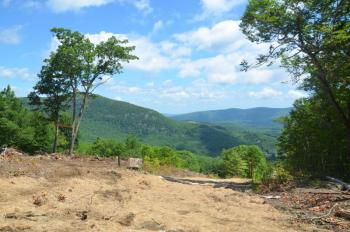
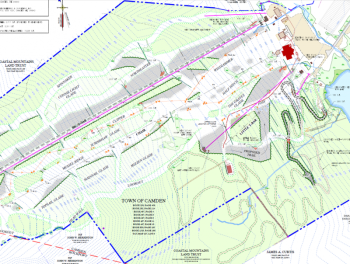 A map of what has been cut and what is left to cut.
A map of what has been cut and what is left to cut.
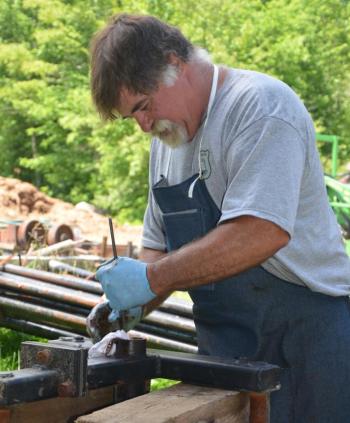 Getting the shivs in condition for the chairlift. (Photo by Lynda Clancy)
Getting the shivs in condition for the chairlift. (Photo by Lynda Clancy)
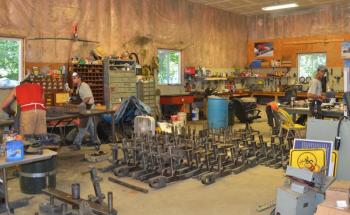 The shop at the Camden Snow Bowl, July 9. (Photo by Lynda Clancy)
The shop at the Camden Snow Bowl, July 9. (Photo by Lynda Clancy)
CAMDEN — The owner of Royal Trail Works Inc., of Royalton, Vt., stood before the Camden Select Board and concerned citizens Tuesday evening, July 8, declaring that silt run-off conditions on Ragged Mountain had been retained, and that conditions were improving at the Snow Bowl.
“Ninety-five percent of the silt has stopped in the last week alone,” said Tom Wells. “We do have a plan. I have done this many times. We are going to stop the silt. We will see green coming through that mulch. We have seen the worst of it.”
He was responding, in part, to several neighbors of the Snow Bowl, who were speaking one by one before the Select Board at its regular meeting. They made pointed observations and raised questions about the performance and oversight of the spring logging on 15 acres of the mountain, which resulted in silt run-off to Hosmer Pond and has likely earned enforcement action from the Maine Department of Environmental Protection.
“How long do we expect the muddy water to continue this summer?” asked landowner Hidetaro Suzuki.
The run-off followed incidents of heavy rain, and deposited much silt from the tree-cleared slopes into the pond, which lies at the foot of the mountain.
Read Snow Bowl mountain mud runoff causes headache for neighbors, town and Camden Snow Bowl prepped for more rain, assembling working group to assist with next steps.
The public input followed a short presentation by Camden’s Park and Recreation Director Landon Fake, who told the board that the erosion’s emergency remediation included putting a turbidity boom in Hosmer Pond, placing 600 bales of hay on seven acres of hillside, as well as 300 cubic yards of erosion-control mulch berms.
He said the pond is clearing and it is safe for swimming. The E. coli bacteria count is below what is considered safe by the U.S. Environmental Protection Agency, he said. Samples of E. coli from recreational waters are acceptable for swimmer’s protection, according to the EPA, if they measure less than 126 E. coli per 100 milliliters of fresh water. Elevated fecal indicator bacteria are often associated with storm water run-off, he said.
On July 1, samples from Hosmer Pond measured 39 per 100 milliliters. By contrast, he showed the Select Board, Norton Pond measured 78 while both Barrett’s Cove and Shirt Tail Point measured 5 per 100 milliliters.
Rock check dams had been installed in drainage ditches, as were hundreds of feet of silt fence, added Fake.
He said the Rockport landscaping company Farley and Son sent crews to help at the mountain for four days, including over July Fourth holiday weekend.
“Farley and Son had 40 people out there working under lights,” said Fake. “Aldermere Farm donated 200 bales of hay and Midcoast Solid Waste Corporation provided 150 yards of erosion control mulch. Volunteers from the ski club and Ragged Mountain Foundation came out on five hours July 4 to stake hay bales.”
Crews also built more than 15 water bars, which divert rainwater coursing down the mountain to the sides of the slopes.
Neighbors, however, were not reassured by Fake’s report, and questioned the effectiveness of the erosion-control measures. How would the town ensure protection of the pond going forward with the final piece of logging, and the next phase, the construction of trails, they asked.
They also advocated for a project manager well versed in construction projects to be appointed to oversee the Snow Bowl upgrade.
After Fake updated the board, he asked Wells to describe further what his role and methods would be.
Wells told the board the mountain was in better shape.
“From last week to this week, it is amazing see that project come together with speed and technology they used, and effort put forth,” said Wells.
Wells has stepped into the lead almost by default, following the abrupt departure of the logging company that had been clearing the mountain slopes to widen trails. He sat with the Select Board in the front of the Washington Street Meeting Room and explained his role, saying that the erosion control at the Snow Bowl “is definitely under control, especially considering you had a 3-inch rain.”
Wells’ company, Royal Trail Works, was the successful bidder on the Camden Snow Bowl next phase of its $6.5 million upgrade, the infrastructure and ski trail improvement portion of the project. It is also one of the large project phases, and Wells bid approximately $1 million, winning the job over another Vermont trail-building company, G. W. Tatro, which quoted $1.2 million to complete the work.
The infrastructure and trail-building portion of the upgrade includes constructing new trails and widening old ones, adding snowmaking capacity to the new terrain, creating access roads to the top of both the double and triple chairlifts, and making several other small trail improvements to improve skier flow and grooming efficiency.
Wells had hoped to begin his phase of the project in June, but told the Select Board July 8 he anticipated working on the trails into September. The municipally-owned Snow Bowl hopes to open the mountain with its new layout and new chairlifts in place by December.
Snow Bowl improvement goals
In 2008, Camden voters approved a non-binding measure that positioned support for borrowing up to $2 million for Ragged Mountain Recreation Area improvements, if matched by a minimum of $4.5 million raised via private money.
Following that vote, project proponents commenced soliciting contributions, as well as holding public fundraisers. The committee met the $4.5 million mark.
The matching funds — $2 million of town funds and $4.5 million in donations — are to be expended together, not one before the other, and expenditures are planned to match the cash flow of donations over a two-year period.
The cost of borrowing $2 million to the taxpayers could average $110,000 in annual interest payments for 30 years
The capital improvement project at Ragged Mountain entails making mountainside improvements in 2014 and constructing a new lodge in 2015.
The intent is to “provide the capacity to accommodate up to 600 skiers per day with adequate parking, lodge space, uphill lift capacity, and ski terrain serviced by snowmaking and enhance year-round trail use for hikers and mountain biking,” according to the plan. The mountain has been supported by the town in varying degrees since the town assumed ownership of its real estate and operations in 1983.
In 1990-91, Camden voters approved funding the Snow Bowl with $149,000 of their tax dollars; in 2009-2010, it was $55,000. Last year, and following several years of good snowfall, the town contributed zero dollars.
The Redevelopment Committee has built a detailed finance and budget analysis of the Ragged Mountain Recreation Area through 2016, incorporating the entire mountain upgrade. Aside from debt obligation, the projected budget includes no town matching funds in 2015 and 2016.
Instead, the budget anticipates additional revenue will derive from the increased numbers of daily and season ski tickets, ski school enrollment and new lodge rentals..
“There are a couple of new technologies I hope to use here,” he said.
One is an 5,000-pound excavator with stump grinder on it.
“The grinder has the same teeth that they grind roads with,” he said. “It runs at slower rpms and will grind the stump in place. It will go down into the ground 2 feet and grind it up.”
The environmental control is better, he said, because the soil and wood fiber are mixed together and hold the slope. Mulching the soil and chips leaves all the nutrients in place, he said.
“It would be ideal not to skid the trees down the slopes,” said Fake, in his presentation.
“I intend to remove those trees in the safest manner possible to protect that environment,” said Wells. “We pride ourselves on erosion control. Seeding and mulching daily. I don't think you will see anything you had in the past.”
Wells has moved a collection of large equipment — excavators, two bulldozers and four wide loaders — from Vermont to Camden for the job. He employs four on the site and plans to hire a few more local contractors to help with the trail construction.
“We aim for a golf course, even though it is a ski trail,” he said.
Wells and Fake both said July 10 that the town and the company have yet to negotiate a price above and beyond that which was included in the bid to cut the final two acres of trees.
Fake said the emergency erosion control measures, including hiring additional help on the hill, will add almost $30,000 to the project cost.
The $6.5 million project, which also includes engineering infrastructure and building a new lodge, is funded partially by private donations ($4.5 million) and $2 million by Camden taxpayers, who approved a bond at the polls last year.
The new lodge will be constructed next summer, and the existing lodge will remain to be used as the ski school and for other functions.
“We have a good launch pad,” said Wells. “I would prefer if this were the first week of June.”
In other Ragged Mountain project news
The design and layout of the new used triple chairlift is complete and the construction of its tower structure is under way.
The chair grips, which fasten the chair to the cable, are back from their structural testing.
The grips for the old double chairlift are now under going stress testing.
Camden town employees were busy July 9 in the workshops and outside assembling sheaves for the lifts.
Improvements include repurposing the existing double-chair lift, removing both T-bars and installing a used triple-chair lift to the top of the mountain, near the same path of the existing Big-T. Design and engineering for this aspect of the overhaul is a large component of the entire project.
The plan also entails keeping the existing lodge for race training and events, and building a new 8,500-square-foot lodge with seating for 200 and food service.
Snowmaking is to be be expanded from 40 percent to over 80 percent coverage, including the improved novice area and the top of the mountain.
Components of the project carry estimated price tags:
1) Purchase of the triple-seat chairlift, reconfiguration of existing lift, removal of T-bars: $1 million.
2) Improving snowmaking and equipment, trailwork, power upgrade and distribution: $2.5 million.
3) New lodge: $2 million.
4) Architecture, design, engineering, consultants: $1 million.
Related stories
• Ready for packed powder? Camden Snow Bowl to make it quicker, sooner with updated guns
• Camden pursues federal money to help fund Snow Bowl upgrade
• Camden's Ragged Mountain loses good friend
• By wide margin, Camden voters approve Snow Bowl improvement bond
• Camden Select Board to discuss Snow Bowl chairlift replacement
• Snow Bowl ready to put $2 million mountain bond before Camden voters
• Snow Bowl mountain mud runoff causes headache for neighbors, town
• Camden Snow Bowl prepped for more rain, assembling working group to assist with next steps.
Editorial Director Lynda Clancy can be reached at lyndaclancy@penbaypilot.com; 706-6657.
Event Date
Address
United States

